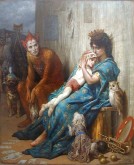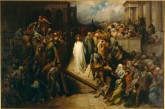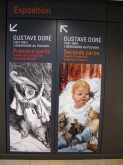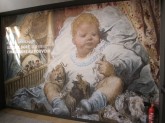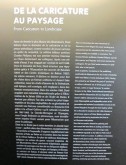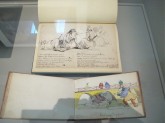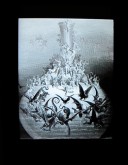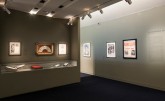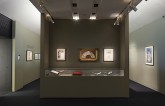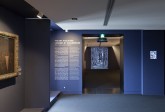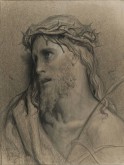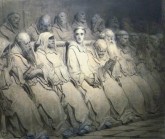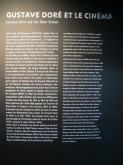The browser will either open the file, download it, or display a dialog.
Gustave Doré (1832–1883): Master of Imagination
Musée d’Orsay, Paris
February 18–May 11, 2014
National Gallery of Canada, Ottawa
June 13–September 14, 2014
Catalogue:
Doré: Master of Imagination.
Edited by Philippe Kaenel.
Paris: Flammarion, in association with the Musée d’Orsay and the National Gallery of Canada, 2014.
335 pp., 113 color illus.; 174 b&w illus. (some half-tones); bibliography; index.
€45.00; $60 Canada and United States
ISBN 978-2-089-131643-0
Although Gustave Doré is internationally recognized as one of the most creative illustrators of the nineteenth century, his work in other areas such as painting and sculpture has remained known only to specialists of the period. This problem has recently been extensively addressed in a detailed and elaborate thematic and monographic exhibition at the Musée d’Orsay in Paris, where much of the productive work of Doré is presented in a carefully developed exhibition that showcases the artist as a force of promethean abilities. The organizers of the exhibition, and the accompanying catalogue, have tried to reveal how the artist was driven to do many of his works. Doré emerges as an artist determined to succeed in all areas of creativity, to move beyond being seen as simply an illustrator of stories, through works in all media that often have personal links to his life, to the ways in which he was influenced by society, and to the effects of misery and melancholy that haunted the artist. The impact of this exhibition is electric. The exhibition engages the attention of the viewer, forcing her/him to confront the established myths of this artist by seeing him in a new imaginative way.
In the introductory sections of the show many themes were visually and contextually introduced that were maintained throughout the exhibition. Doré is seen as an outcast, as a figure excluded from the higher realms of creativity because of his reliance on illustration to make his living. His ability to depict performers or acrobats in a new way, however, conveys a strange disconcerting atmosphere (figs. 1, 2). The Family of Street Acrobats: the Injured Child and The Street Performers or The Injured Child, presented twice in the show (in two variants from 1873 and 1874, Denver Art Museum and Collection of the Musée d’art Roger-Quilliot, Clermont-Ferrand) is used by Doré to comment on the effects of misery and alienation on the performers and by implication, the artist (Doré was himself an accomplished acrobat). Even the drawing of Pierrot grimaçant (Pierrot Grimacing) (not dated, Musée d’Art Moderne et Contemporain, Strasbourg), while suggesting that Doré knew some works by Honoré Daumier, provides a decidedly original implication. A clown is not only an amusing individual, but this performer is both hurt and suffering. Within these early thematic sections Doré’s painting of The Last Judgment (1879, Musée des beaux-arts, La Rochelle) stands out. Although created late in his career, it conveys that the fits of melancholy he suffered were reinforced through some religious paintings, done on a grand scale, whose black and white color scheme reinforced the dour, serious tone of the composition. Visions of hell and final judgment were factors that forced Doré onward in his creative endeavors.
One sector that was new in this exhibition was Doré as a sculptor. While he was never trained in this medium, the Exhibition Guide notes that Doré effortlessly acquired “a virtuosity on a par” with what he was doing as a painter. His new imagery began in 1877 with the large-scale Fate and Love (1877, Musée de Brou, Bourg-en-Bresse), which presents an unusual allegory of life, employing symbols of mortality such as an oversized hourglass. Here academic naturalism and allegorical symbolism are used to effect, but the work was severely chastised by the established art critic Jules-Antoine Castagnary who believed that Doré had no talent as a sculptor. Craving attention for his sculpture, he was bitterly upset and frustrated by this rejection, although he maintained his determination to succeed in other areas.
Another significant area presented early in the show was the way in which Doré saw religion as theatre. Whether it was the work that he exhibited in London (1867–68) at the Doré Gallery or his huge paintings, such as Christ Leaving the Praetorium, (1874–80, Musée des Beaux-Arts, Nantes) Doré’s reputation as a “preacher painter” (which is carefully assessed in a catalogue essay by Philippe Kaenel) is noted (fig. 3). His paintings had power; they were dramatic and spectacular, becoming almost stage presentations in themselves. Importantly, his paintings inspired passion plays, tableaux vivants, and ultimately the early silent cinema. More than this, Doré’s ability to work in all the areas of the arts simultaneously reveals that he was a true Renaissance man. One of the themes that was not addressed in the show, or the catalogue accompanying it, was the way in which this artist revitalized an established tradition and made it into something new, exciting and meaningful for many, not just a few elite patrons. This was one of the major achievements of this exhibition, although it was not discussed in the wall texts or in the catalogue.
As the exhibition continued, the visitor moved from the first to the fifth floor of the Musée d’Orsay where several posters showed visitors where to go (figs. 4, 5). Once inside the upper section, a large wall text helpfully explained how Doré’s career evolved from caricature to landscape (fig. 6). Much attention rested on the way Doré began his career as a caricaturist working with periodicals (fig. 7). Some of his earliest works reflect his links with the orbit of the Parisian publisher, Charles Philipon, a personality noted for his support of incendiary lithographs that often attacked those in power. Some early sketchbooks, carefully situated in display cases, forced the visitor to look at the evolution of Doré’s caricatures, and show his awareness of the work of Honoré Daumier and Cham (né Charles Amédée de Noé), with Daumier becoming a particularly staunch advocate of his work. By 1848 his contract with Philipon led to a series of significant images, and to his work in the production of book illustration—the area in which Doré’s work was best known and where he made a considerable mark (fig. 8). Seen as a child prodigy, whose early illustrations were influenced by J. J. Grandville and Rodolphe Töpffer, this designation propelled his career forward. But it was his production of book illustrations for the works of Rabelais (1854) and Balzac (1855) that increased his visibility. The exhibition carefully reconstructed these illustrations, providing significant ways in which a viewer could see many images since they were projected in small light boxes in the exhibition itself (fig. 9); these images moved, suggesting the turning of a page in a book. The inclusion of posters, such as one for the availability of his Rabelais illustrations, demonstrated one of the most effective ways in which Doré’s work was advertised and promoted, eventually spreading the fame of his illustrations beyond the borders of France. Considering the number of illustrations that Doré completed, this section of the exhibition required intense concentration on the part of a viewer combined with a close look at numerous works. Since the exhibition used a series of cases, it was possible to study these works intimately, although the crowds that often came to see the exhibition frequently made it very complicated to examine these prints without feeling pressure to accommodate others.
The headings for the wall texts clarified the thematic groupings in the exhibition, such as the section revealing Doré as a “Child Prodigy,” or a “Popular Illustrator” (figs. 10, 11); the visitor always had a clear way to follow the evolution of his career without the fear of getting lost in a welter of images. In the section where his illustrations for Rabelais were presented, for example, the emphasis shifted to Doré’s general “Creation of Book Illustration” with inventive ways of revealing how his career was improving (fig. 12). When Doré’s work on “London and Shakespeare” was presented, a carefully developed wall text provided necessary information on what he was accomplishing, while letting a number of the images on the wall further tell the story (fig. 13). Doré’s depiction of the poor of London, both through published book illustrations and a series of powerful drawings, reflected the sympathy he had for the dispossessed (fig. 14). His presentation of London: A Pilgrimage with text by Blanchard Jerrold (1872) provided the fulcrum around which a series of Doré’s most moving images were installed.
As David Skilton’s short text in the exhibition catalogue clearly expostulated, “Doré stands alongside Dickens in the imaginations of later ages as a supreme portraitist of the city; negatively, in that his images have been taken as virtually factual, photorealistic evidence reproduced on countless websites to represent Victorian London to today’s audiences” (148). But Skilton goes further in analyzing these images, which did not simply illustrate the text by Jerrold, but were independent works that stand alone as works of art. Doré was simply “guided by Jerrold’s words” as his images are linked to Jerrold’s “. . . text only by the circumstances of its conception and publication” (148). While these ideas were not presented in the exhibition itself, the catalogue essay offers a visitor further insight into the ways in which Doré’s nocturnal first-hand visits to disreputable sections of London provided him with the basis of portraying the city as a dangerous metropolis fraught with abject poverty.
After exploring Doré’s London, the exhibition next examined Doré’s interest in Spain. As the Exhibition Guide states, “unlike London, Spain is depicted as a wild and picturesque land.” While not exactly the way in which Doré saw Spain, the pamphlet was useful for a quick overview; more effective was the wall text where it was noted that Doré’s several trips to Spain allowed him to do paintings inspired by Cervantes’s Don Quixote. Other works stressed the “nobility of Spanish beggars,” especially visible in the Beggars at Burgos (1875, Private Collection), a very moving example of his creative power. Especially useful in this section was the placement of a wood block used by Doré for his illustrations to Don Quixote; once again, the way in which Doré actually worked helped a visitor visualize his achievement.
By the time a visitor reached the end of this part of the exhibition he/she had been bombarded by a rich panoply of images and ideas, many of which were chronologically simultaneous. Without moving directly into the other sections of the show, a brief respite was provided, including a chronology of Doré’s life, along with his key moments of creativity, as well as a space where one could sit to study the chronology provided on the wall. This gave the contemplative viewer an opportunity to take stock of what had already been presented; it also gave the historical foundation for the remainder of Doré’s career beginning with the fateful year of 1870 when he joined the National Guard during the conflagration with Prussia. The wall text notes that during 1871, at the moment of the Paris Commune, Doré was in Versailles where he did expressive drawings of a number of imprisoned communards. He also did a series of patriotic paintings and drawings. The success of London: A Pilgrimage (1872) added to Doré’s fame, and gave rise to new book projects including The Rime of the Ancient Mariner (1875) which was unsuccessful. Its failure forced Doré to sell seventy-eight drawings at the Hôtel Drouot to cover the costs of this book. Providing the historical context for Doré is crucial for the next theme in the exhibition “The Terrible Year”. It was here, as was the case with some of his drawings of poverty in London, that one was moved by the effectiveness of Doré’s allegories of intense suffering.
Upon entering “The Terrible Year” the wall text, as well as the educational handout, reminded one that Doré was “. . . witness (to) many tragedies and episodes of ruin.” Working from his field notes, Doré created the Black Eagle of Prussia (1871, Dahesh Museum of Art, New York), which keynotes the somber reality of the moment both through the dark tones of black and grey as well as by the foreboding allegory of Prussian dominance (fig. 15). The climate of war, reinforced by the canvas titled Enigma, (1871, Musée d’Orsay, Paris) created a mood of dire collapse and questioning (fig. 16). These large canvases, grouped together in one room, raised questions as to France’s preparedness for the confrontation; the civil war that followed, which destroyed a good part of the city of Paris, was a somber reminder of what war brings. But it was the loss of Doré’s native Alsace that dominated his reactions, further escalating the direct impact of the war on the artist. As was the case earlier in his career, Doré produced some of his most affecting works when he was personally involved. This is certainly true with the powerful drawing of The Bombardment of Paris, also known as The Siege of Paris (1870, Société industrielle de Mulhouse, on deposit at the Musée des Beaux-Arts, Mulhouse) where soldiers and family members, moving with a few of their possessions, try to leave Paris to find safety elsewhere. When Doré worked as a pure realist the effectiveness of his imagery was overwhelming.
With “Religion and Pathos,” the following section in the show, the exhibition returned to a theme that was presented in the introductory area. This was an effective way to remind the viewer just how significant this type of artwork had been for Doré while moving toward recognizing that his monumental Holy Bible (published in 1866) was a decisive moment in his career. Strongly influenced by Ernest Renan’s 1863 book, Life of Jesus, the artist continued to humanize Christ. Doré’s study of the works of Rembrandt, an artist effectively revived during the nineteenth century, led to Christ as Man of Sorrows (1874, Musée Tavet-Delacour, Pontoise) and Neophyte (1869, Musée d’Art Moderne et Contemporain, Strasbourg) some of the most effective images in the exhibition (figs. 17, 18). Doré’s merging of romantic allegory with an interest in Orientalism pushed him forward so that his paintings and drawings appear both sensitively developed and of the moment. He was determined not to let his approach grow stale as he continually challenged himself in new ways. Finding new ways to handle themes that were in the air is revealed here.
It was in one of the last segments of the show that Doré’s extraordinary ability and creativity in painting shone. With the extensive display of many large-scale paintings, his “Picturesque and Sublime Landscapes” established him as one of the foremost landscape painters of the nineteenth century (figs. 19, 20). These paintings, completed from the 1860s onward, have never been grouped together; with them, the human figure is almost eliminated so that the incomparable majesty of mountains and vast topographic panoramas overwhelm the spectator. The effective employment of changing light effects reveals that Doré understood what he was seeing in different locations while maintaining the practice of recomposing these romantic visions in the solitude of his studio. Suggestive of the works of the Swiss landscapist Alexandre Calame, as well as the romantic compositions of Caspar David Friedrich, Doré’s Sunrise over the Alps (1873–77, Leeds Museums and Galleries, Leeds) or his Loch Lomond (1875, Saint Louis Art Museum, St. Louis) are reminders that Doré’s imagination encompassed all areas and genres of creativity. It was a fitting climax to his career.
The final section of the show explored Doré’s influence on the new phenomenon of the twentieth century: the motion picture (fig. 21). In “Gustave Doré and the Silver Screen” his relationship with movies was dramatically acknowledged. Using a few film clips, projected in a darkened space, the visitor was given the opportunity to briefly see how every film about the Bible, since the Life and Passion of Jesus Christ (Pathé, 1902) was directly inspired by Doré’s illustrations. Clearly the dramatic lighting in some of his huge paintings, and the ways in which he created with almost a cinematic flair for staging and drama, made his work—all of it—seem even more fully important for our own century. Once again, by going beyond a formulaic construction of a typical art historical exhibition, the organizers created a model that other curators must take note of in their own exhibitions.
What then is the overall achievement of this exhibition? What does the show do to focus study on the various modes of Doré’s creativity? The answers to these questions lie in the way the curators have seamlessly examined Doré from all aspects—simultaneously—so that it is possible to see that he was a total creator, not a one-dimensional illustrator. By grouping works in different thematic sections and maintaining a chronology while demonstrating how various themes interweave themselves throughout Doré’s life, they have provided a challenging and exciting way to present a monographic show. Unfortunately, while the exhibition catalogue contains a number of substantial and interpretive essays, especially those written by Philippe Kaenel, the placement of the images with the texts are haphazard at best and continually confusing. The catalogue suggests it was prepared in haste without a clear understanding of how the exhibition was to be organized and little integration with the texts provided by scholars. A massive tome, it suggests that as much care and precision should be expended on the publication as obviously has been achieved with the show itself. Aside from this, the exhibition presents a unique way to appreciate an artist many thought they knew, but who emerges through this show as a towering, imaginative genius fulfilling the nineteenth-century call to find a painter who could capture many of the nuances of modern life.
Gabriel P. Weisberg
University of Minnesota
vooni1942[at]aol.com



